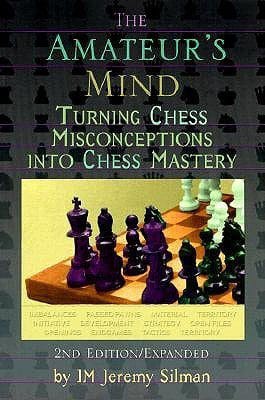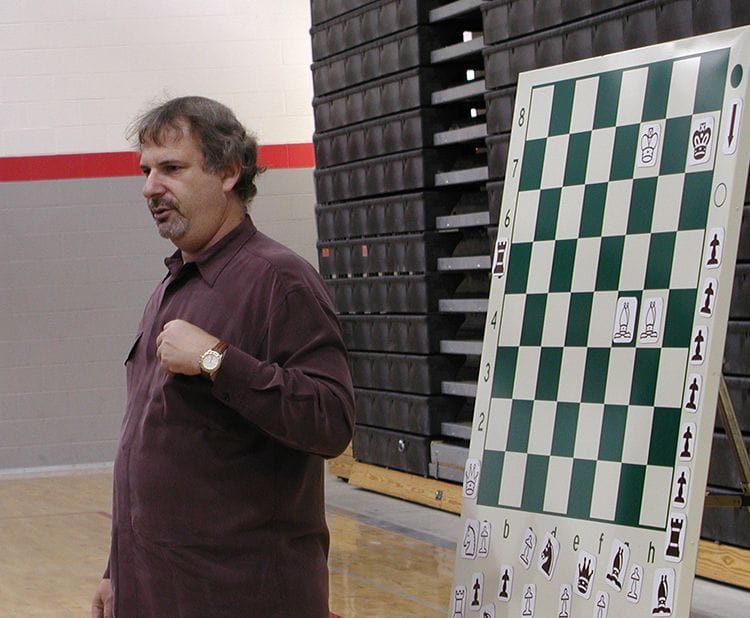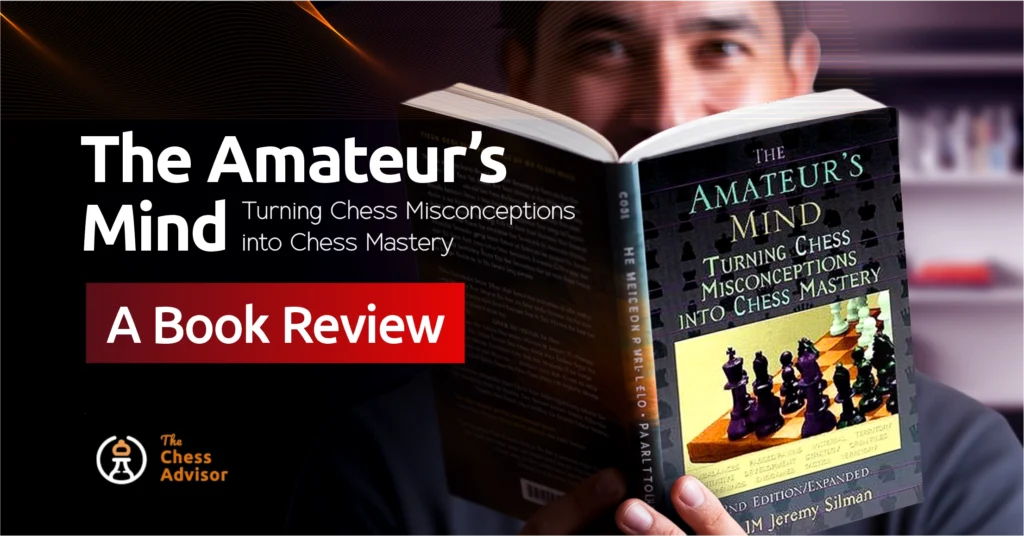It’s a feeling every developing chess player knows intimately. You’ve survived the opening and there are no immediate tactical threats. But you look at the board and have no idea what to do next.

Ten turns later, your position mysteriously crumbles, leaving you wondering where it all went wrong.
The gap between basic chess knowledge and a fundamental understanding of the game is where most players get stuck.
International Master Jeremy Silman’s classic work, “The Amateur’s Mind: Turning Chess Misconceptions into Chess Mastery,” was written to try and bridge this gap.
The book claims to diagnose and cure the flawed thought processes that lead to bad moves.
This review will dissect the content and explain “The Amateur’s Mind” unique teaching method.
About the Author: IM Jeremy Silman

Jeremy Silman was one of America’s most influential chess educators. He died September 2023, having authored over 36 books. He was often labelled as America’s chess teacher.
He was an International Master who won prestigious tournaments like the American Open, the National Open, and the U.S. Open.
His works are known for their practical approach to making complex chess concepts understandable.
What Is This Book About?
“The Amateur’s Mind” was first published in 1995 with a unique approach to teaching chess. He focused more on improving the thinking process of amateur players.
Rather than analyzing perfect games or presenting theoretical positions, Silman recorded the actual reasoning of his students as they played real games.
Silman then deconstructs the student’s thought process during the game. He highlighted and corrected errors in their reasoning process.
This format is incredibly effective because you see the correct answer and understand why your initial instincts were wrong. It feels less like reading a book and more like receiving a one-on-one lesson.
Book Content Summary
The book is divided into three core parts that cover different chapters in the book.
Part 1: The Imbalances
This part of the book covers Chapters 1 to 7. It introduces the concept of “imbalances”. Silman argues that while amateurs are lost in random calculations, masters identify these imbalances.
The core imbalances he identifies are:
- Superior Minor Piece: Understanding when one minor piece is superior to the other and how to create positions that favor your pieces.
- Pawn Structure: Recognizing the strengths and weaknesses of different pawn formations and knowing how to play with or against them.
- Space: The amount of territory each player controls and the advantages gained by dominating key squares and areas of the board.
- Material: How material advantages and disadvantages should be handled in different positions.
- Control of a Key File or Square: Dominating a critical rank, file, diagonal, or outpost.
- Development: How quickly and effectively bring your pieces into the game.
- Initiative: The ability to make threats and force your opponent to react, thereby controlling the flow of the game.
Part 2: Applying the Knowledge
This part of the book covers Chapters 8 to 12. It moves from defining the individual imbalances to applying them in practical game situations. The key topics covered are:
- How to Play the Opening: Silman explains how to make purposeful decisions that create favorable imbalances from the very start of the game.
- Proper Use of Rooks: This explains using “heavy artillery” to control open files and the importance of the seventh rank.
- The Curse of the Mindless King Hunter: Silman explains how to objectively assess whether an attack on the king is justified by the position’s imbalances.
- Which Side of the Board to Play On: Players learn to identify whether their plan should be executed on the kingside, queenside, or in the center.
- Developing Mental Toughness: This section discusses how to handle fear and maintain focus.
Part 3: Testing and Reinforcement
This final part of the book is dedicated to testing the reader. The expanded second edition features a large collection of 26 tests. Each test presents a chess position, and the reader is challenged to use Silman’s method to solve it.
Who Should Read This Book
The sweet spot for this book is generally considered to be players rated between 1200 and 1800 Elo.
It is ideal for players struggling with planning and strategy despite adequate tactical knowledge.
Self-taught players with gaps in understanding are another group that would find value in this book.
Pros of the Book
The greatest strength of “The Amateur’s Mind.” is its unique teaching method. By presenting the actual thoughts of amateur players, Silman makes the lessons relatable.
Silman’s writing style is another major asset. He is engaging, clear, and injects a healthy dose of humor into his instruction.
The framework of imbalances provides a checklist of what to look for in any given position, especially during the middlegame.
The book also avoids overwhelming the reader with endless, computer-generated variations.
Cons of the Book
Some readers have found the number of guidelines to be overwhelming. The imbalance checklists one has to run through can be too much for some players to remember.
Another point of contention is the book’s strong emphasis on positional strategy, sometimes at the expense of tactics. A player who is still frequently losing to simple forks and skewers might rather get a dedicated tactics book.
Finally, as with any chess book written before the modern engine era, some of the specific move analyses might be challenged by today’s chess engines.
Final Verdict and Rating
“The Amateur’s Mind” provides a good roadmap for any intermediate player who feels stuck formulating middle game plans.
Jeremy Silman offers a framework for deep strategic understanding by correcting the very thought processes that hold amateurs back. It teaches you not just what to do, but how to think.
The book’s combination of technical instruction, psychological insight, and practical application makes it a standout work in chess education.
Rating: 4.5/5 ★★★★⯨
